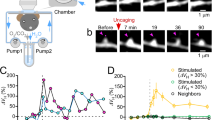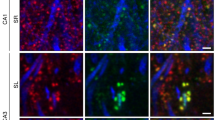Abstract
Sensory experiences exert a powerful influence on the function and future performance of neuronal circuits in the mammalian neocortex1,2,3. Restructuring of synaptic connections is believed to be one mechanism by which cortical circuits store information about the sensory world4,5. Excitatory synaptic structures, such as dendritic spines, are dynamic entities6,7,8 that remain sensitive to alteration of sensory input throughout life6,9. It remains unclear, however, whether structural changes at the level of dendritic spines can outlast the original experience and thereby provide a morphological basis for long-term information storage. Here we follow spine dynamics on apical dendrites of pyramidal neurons in functionally defined regions of adult mouse visual cortex during plasticity of eye-specific responses induced by repeated closure of one eye (monocular deprivation). The first monocular deprivation episode doubled the rate of spine formation, thereby increasing spine density. This effect was specific to layer-5 cells located in binocular cortex, where most neurons increase their responsiveness to the non-deprived eye3,10. Restoring binocular vision returned spine dynamics to baseline levels, but absolute spine density remained elevated and many monocular deprivation-induced spines persisted during this period of functional recovery. However, spine addition did not increase again when the same eye was closed for a second time. This absence of structural plasticity stands out against the robust changes of eye-specific responses that occur even faster after repeated deprivation3. Thus, spines added during the first monocular deprivation experience may provide a structural basis for subsequent functional shifts. These results provide a strong link between functional plasticity and specific synaptic rearrangements, revealing a mechanism of how prior experiences could be stored in cortical circuits.
This is a preview of subscription content, access via your institution
Access options
Subscribe to this journal
Receive 51 print issues and online access
$199.00 per year
only $3.90 per issue
Buy this article
- Purchase on Springer Link
- Instant access to full article PDF
Prices may be subject to local taxes which are calculated during checkout




Similar content being viewed by others
References
Wiesel, T. N. & Hubel, D. H. Single cell responses in striate cortex of kittens deprived of vision in one eye. J. Neurophysiol. 26, 1003–1017 (1963)
Clark, S. A., Allard, T., Jenkins, W. M. & Merzenich, M. M. Receptive fields in the body-surface map in adult cortex defined by temporally correlated inputs. Nature 332, 444–445 (1988)
Hofer, S. B., Mrsic-Flogel, T. D., Bonhoeffer, T. & Hübener, M. Prior experience enhances plasticity in adult visual cortex. Nature Neurosci. 9, 127–132 (2006)
Bailey, C. H. & Kandel, E. R. Structural changes accompanying memory storage. Annu. Rev. Physiol. 55, 397–426 (1993)
Yuste, R. & Bonhoeffer, T. Morphological changes in dendritic spines associated with long-term synaptic plasticity. Annu. Rev. Neurosci. 24, 1071–1089 (2001)
Trachtenberg, J. T. et al. Long-term in vivo imaging of experience-dependent synaptic plasticity in adult cortex. Nature 420, 788–794 (2002)
Grutzendler, J., Kasthuri, N. & Gan, W. B. Long-term dendritic spine stability in the adult cortex. Nature 420, 812–816 (2002)
Majewska, A. K., Newton, J. R. & Sur, M. Remodeling of synaptic structure in sensory cortical areas in vivo . J. Neurosci. 26, 3021–3029 (2006)
Holtmaat, A. J. et al. Transient and persistent dendritic spines in the neocortex in vivo . Neuron 45, 279–291 (2005)
Sawtell, N. B. et al. NMDA receptor-dependent ocular dominance plasticity in adult visual cortex. Neuron 38, 977–985 (2003)
Gordon, J. A. & Stryker, M. P. Experience-dependent plasticity of binocular responses in the primary visual cortex of the mouse. J. Neurosci. 16, 3274–3286 (1996)
Hensch, T. K. et al. Local GABA circuit control of experience-dependent plasticity in developing visual cortex. Science 282, 1504–1508 (1998)
Huang, Z. J. et al. BDNF regulates the maturation of inhibition and the critical period of plasticity in mouse visual cortex. Cell 98, 739–755 (1999)
Mrsic-Flogel, T. D. et al. Homeostatic regulation of eye-specific responses in visual cortex during ocular dominance plasticity. Neuron 54, 961–972 (2007)
Tagawa, Y., Kanold, P. O., Majdan, M. & Shatz, C. J. Multiple periods of functional ocular dominance plasticity in mouse visual cortex. Nature Neurosci. 8, 380–388 (2005)
Fischer, Q. S., Graves, A., Evans, S., Lickey, M. E. & Pham, T. A. Monocular deprivation in adult mice alters visual acuity and single-unit activity. Learn. Mem. 14, 277–286 (2007)
Mataga, N., Mizuguchi, Y. & Hensch, T. K. Experience-dependent pruning of dendritic spines in visual cortex by tissue plasminogen activator. Neuron 44, 1031–1041 (2004)
Feng, G. et al. Imaging neuronal subsets in transgenic mice expressing multiple spectral variants of GFP. Neuron 28, 41–51 (2000)
Wang, Q. & Burkhalter, A. Area map of mouse visual cortex. J. Comp. Neurol. 502, 339–357 (2007)
Heimel, J. A., Hartman, R. J., Hermans, J. M. & Levelt, C. N. Screening mouse vision with intrinsic signal optical imaging. Eur. J. Neurosci. 25, 795–804 (2007)
Holtmaat, A., Wilbrecht, L., Knott, G. W., Welker, E. & Svoboda, K. Experience-dependent and cell-type-specific spine growth in the neocortex. Nature 441, 979–983 (2006)
Knudsen, E. I. Instructed learning in the auditory localization pathway of the barn owl. Nature 417, 322–328 (2002)
Linkenhoker, B. A., der Ohe, C. G. & Knudsen, E. I. Anatomical traces of juvenile learning in the auditory system of adult barn owls. Nature Neurosci. 8, 93–98 (2005)
Knott, G. W., Holtmaat, A., Wilbrecht, L., Welker, E. & Svoboda, K. Spine growth precedes synapse formation in the adult neocortex in vivo . Nature Neurosci. 9, 1117–1124 (2006)
Nägerl, U. V., Kostinger, G., Anderson, J. C., Martin, K. A. & Bonhoeffer, T. Protracted synaptogenesis after activity-dependent spinogenesis in hippocampal neurons. J. Neurosci. 27, 8149–8156 (2007)
Kasai, H., Matsuzaki, M., Noguchi, J., Yasumatsu, N. & Nakahara, H. Structure-stability-function relationships of dendritic spines. Trends Neurosci. 26, 360–368 (2003)
Bourne, J. & Harris, K. M. Do thin spines learn to be mushroom spines that remember? Curr. Opin. Neurobiol. 17, 381–386 (2007)
Matsuzaki, M., Honkura, N., Ellis-Davies, G. C. & Kasai, H. Structural basis of long-term potentiation in single dendritic spines. Nature 429, 761–766 (2004)
Kopec, C. D., Li, B., Wei, W., Boehm, J. & Malinow, R. Glutamate receptor exocytosis and spine enlargement during chemically induced long-term potentiation. J. Neurosci. 26, 2000–2009 (2006)
Zhou, Q., Homma, K. J. & Poo, M. M. Shrinkage of dendritic spines associated with long-term depression of hippocampal synapses. Neuron 44, 749–757 (2004)
Acknowledgements
We thank T. Keck for contributing control data for Supplementary Fig. 7a, and M. Sperling and B. Pichler for programming help. This work was supported by the Max Planck Society, the Wellcome Trust and the Humboldt Foundation.
Author information
Authors and Affiliations
Corresponding author
Supplementary information
Supplementary Information
This file contains Supplementary Notes, Supplementary References and Supplementary Figures S1-S7 with Legends (PDF 1326 kb)
Rights and permissions
About this article
Cite this article
Hofer, S., Mrsic-Flogel, T., Bonhoeffer, T. et al. Experience leaves a lasting structural trace in cortical circuits. Nature 457, 313–317 (2009). https://doi.org/10.1038/nature07487
Received:
Accepted:
Published:
Issue Date:
DOI: https://doi.org/10.1038/nature07487
This article is cited by
-
A GPU-based computational framework that bridges neuron simulation and artificial intelligence
Nature Communications (2023)
-
Generalized extinction of fear memory depends on co-allocation of synaptic plasticity in dendrites
Nature Communications (2023)
-
An adaptive behavioral control motif mediated by cortical axo-axonic inhibition
Nature Neuroscience (2023)
-
Adaptive control of synaptic plasticity integrates micro- and macroscopic network function
Neuropsychopharmacology (2023)
-
Realize ultralow-energy-consumption photo-synaptic device based on a single (Al,Ga)N nanowire for neuromorphic computing
Nano Research (2023)
Comments
By submitting a comment you agree to abide by our Terms and Community Guidelines. If you find something abusive or that does not comply with our terms or guidelines please flag it as inappropriate.



